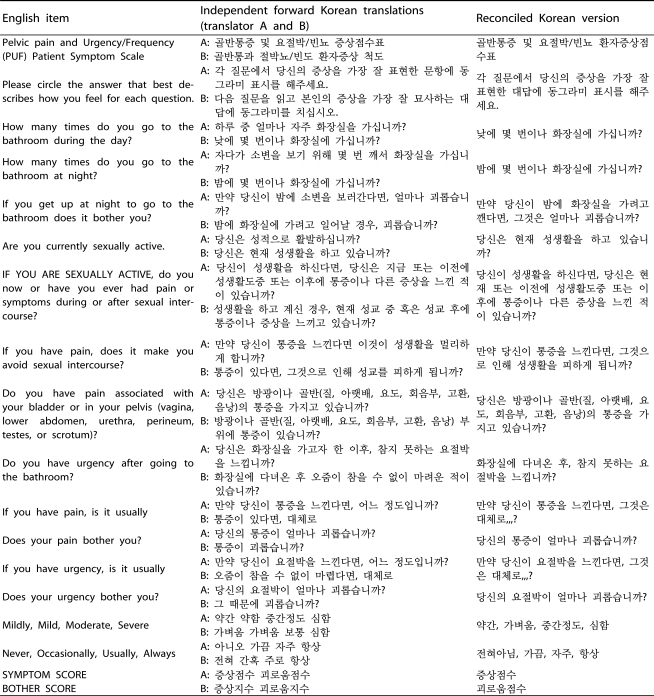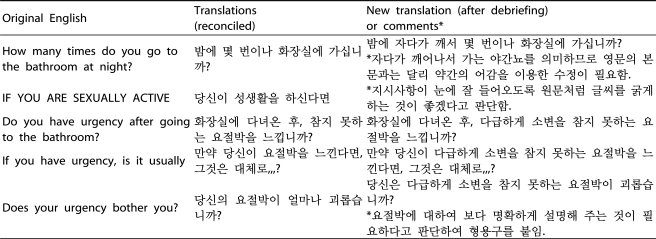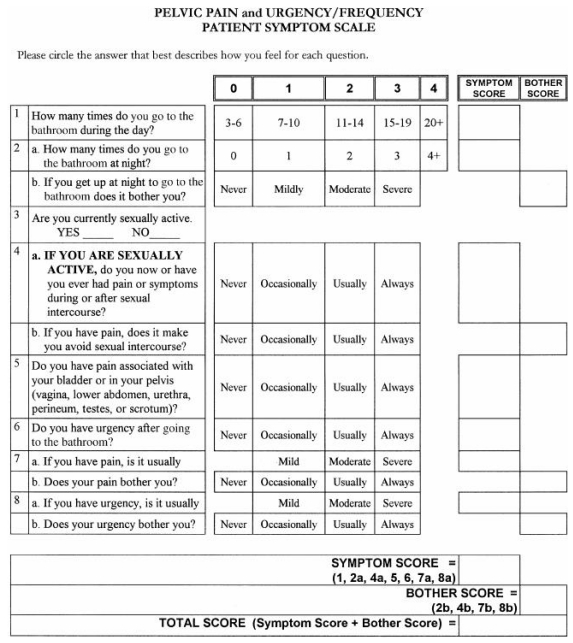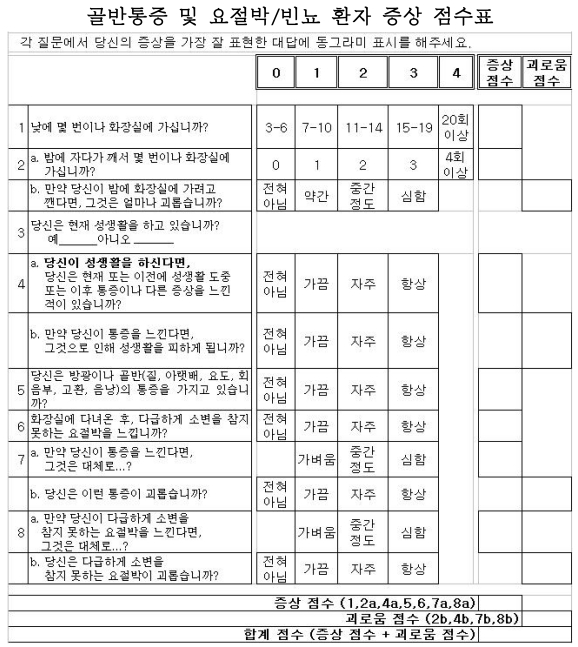Abstract
Purpose
The objective of this study was to achieve a linguistic adaptation of the original version of the Pelvic Pain and Urgency/Frequency (PUF) Patient Symptom Scale into Korean.
Materials and Methods
Between June 2008 and December 2008, a linguistic adaptation was carried out by 2 native Korean speakers who were also fluent in English. First, the original English version of the PUF was translated into Korean. A panel, which included the 2 translators, reviewed the translations to form a single reconciled forward translation of the Korean version. Then, another bilingual translator, having never seen the original version, back-translated the first draft of the Korean version of the PUF into English, and this back-translation was subsequently assessed for equivalence to the original. The panel discussed all discrepancies and produced a second version. After revising the 2nd version, 10 participants [5 interstitial cystitis (IC) patients and 5 persons from the general population], stratified variously by age, sex, and educational level, answered the PUF and were systematically debriefed afterwards. A summary of the changes from the patient interviews were incorporated into the third version. After the spelling, grammar, layout, and formatting were checked, the third version was verified as the final Korean version of the PUF, without modifications.
Results
The multi-step process of forward translation, reconciliation, back-translation, cognitive debriefing, and proofreading of the Korean version of the PUF was completed.
Conclusions
The Korean version of the PUF scale may be helpful for screening IC patients in the Korean population and can now be used in Korea.
Keywords: Interstitial Cystitis, Pelvic pain, Frequency, Scales, Translations
Introduction
Interstitial cystitis (IC) indicates a disease with complaints including urinary urgency, frequent urination, and pelvic pain without other clear pathologic findings such as infection or bladder cancer [1,2]. Patients having IC may have only one of pain-related or voiding-related symptoms, but most of them have both symptoms [3-6]. Although many methods for the correct diagnosis of IC have been presented [7], no specific diagnostic cireteria for IC still exist. Thus, for a patient suspected of having IC, analyzing the patient's answers to a questionnaireis the most basic stage of treatment in order to confirm the patient's symptoms and to measure the degrees of pain and discomfort with objective scores [9].
In 2000 [6] Parsons et al. developed a new questionnaire for IC symptoms titled "the Pelvic Pain and Urgency/Frequency (PUF) Patient Symptom Scale" on the basis of their clinical experiences. As a tool for estimating IC symptoms, the PUF scale is for grading pelvic pain including intercourse-related symptoms, various urination bother symptoms, and the consequent discomfort. Parsons et al [6]. argued that this questionnaire can be used in predicting the results of the potassium sensitivity test (PST), a test that is stated to be a new standard for IC diagnosis [7], and can be helpful in diagnosing IC in all patients presenting with pelvic pain or urination [6].
It is not simple to translate a questionnaire written in one language into a version in another language; the translation must consider differences in the cultures and customs of those who use each language with attention to detail. The purpose of this study was to translate the English-written PUF scale into a Korean version that objectifies the degrees of the symptoms in order to diagnose IC and to assess the linguistic validity of the Korean version. We aimed for domestic researchers to be able to use the Korean version in clinical research and in the clinical treatment of domestic IC patients.
Materials and Methods
Questionnaire as a tool
The PUF questionnaire [6] consists of a total of 12 items. Seven items (1, 2a, 4a, 5, 6, 7a, and 8a) are divided into the symptom score and four items (2b, 4b,7 b, and 8b) are divided into the bother score; the total score is the sum of the two scores (Appendix 1).
Methodology
1) Translation and investigation of linguistic validity: Because Parsons et al., the owner of the intellectual property of the questionnaire, did not act as a mediator in its translation, the first author (H.S.) directly controlled the translation. The translation research consisted of seven stages as follows between June and December 2008 (around 6 months). The main methodology was similar to the translation of the King's Health Questionnaire into a Korean version by Oh et al. [9].
(1) Permission for translation and acquisition of the original version of the PUF questionnaire. The first author (H.S.) was directly in contact with the original author of the questionnaire (Parsons CL), acquired oral permission for the translation, and then received permission for the translation and the use of the original English version of the PUF questionnaire by e-mail.
(2) Forward translation. Two translators (HS and SHK) who were born in South Korea and had lived in an English-speaking nation for at least for 1 year and were versed in both Korean and English listened to the guidelines for the forward translation of the English version of the PUF questionnaire and then translated it separately (ver 1.0a and 1.0b).
(3) Reconciliation. The two translators reviewed the ver. 1.0a and 1.0b and produced a reconciled Korean version (Korean ver. 1.1) after two sessions of meeting.
(4) Back-translation. The ver. 1.1 was back-translated by a third translator who was versed in the two languages. After the original version and the back-translated version were compared, the first author was sent the discordant item concepts between the original and the back-translated sentences. Those items were newly forward-translated, and the translation was literally translated into English for review by the panel. The process was completed when the panel reviewed and accepted the new translation (Korean ver. 1.2).
(5) Debriefing and cognitive debriefing. The Korean ver. 1.2 questionnaire was presented to five outpatients with IC visiting the our hospital and five healthy persons individually in order to investigate the appropriateness of the question items for the patients' situations and the linguistic understanding of each item. Then, each patient underwent an in-depth interview for one hour in which the patient was asked to explain what was asked by each question item. The patients provided feedback when they misunderstood the original concept of a question, when they had difficulty in understanding a question, and when a question was vague or not smooth, and the authors summarized and organized their feedback.
(6) The problems presented during the debriefing were reviewed, and the panel of experts examined the contents. Then, after exchange of feedback, the Korean version 1.3 was completed.
(7) Final proof-reading. From the Korean ver. 1.3, the final Korean version of the PUF questionnaire was completed after checking for errors in spelling or format.
Results
Forward translation and reconciliation
The "Pelvic Pain and Urgency/Frequency (PUF) Patient Symptom Scale" as the questionnaire tool in this study was translated into "Pelvic Pain and Urinary Urgency/Frequent Urination Symptom Score Table" by Translator A and "Pelvic Pain and Urgent Urination/Frequency Patient Symptom Scale," which was finally reconciled as the "Pelvic Pain and Urinary Urgency/Frequent Urination Patient Symptom Score Table" in Korean. The "you" shown many times in the questionnaire was all translated into "dang-sin" (meaning "you" as a term of respect). "[D]uring the day" in Question No. 1 was translated into "during the whole day"by Translator A, but was determined to be "in the daytime" because Question No. 2 asked about nocturnal urination and was opposed to No. 1. "How many times do you go to the bathroom at night?" as Question No. 1-a indicated that you wake up at night for nocturnal urination, thus needing some adaptation for the Korean version. Translator A translated the sentence into "How many times do you wake up to go to bathroom at night?" and the added expression "wake up" was judged to not cause contextual problems. However, after reconciliation, the sentence was literally translated into "How many times do you go to the bathroom at night?" in Korean. "[G]et up at night to go to the bathroom" in Question No. 2-b was translated into "when you urinate at night" by Translator A and into "when you get up to go to the bathroom at night" by Translator B, and it was judged to not cause contextual problems because it was translated into "when you wake up to go to the bathroom at night" in Korean. "Are you currently sexually active?" as Question No. 3 was translated into "Are you currently having sex life?" with some alteration. Question No. 4-a was translated by adding the expression "other" for a smoother interpretation. "[S]exual intercourse" in Question No. 4-b was translated into the more wide-ranging "sex life." "[U]rgency" in Questions No. 6 and 8 was translated into "unbearable feeling the urge to urinate" by Translator B, but was translated into "urinary urgency" by Translator A. In order to enhance understanding, the word was translated into "unbearable urinary urgency" only for Question No. 6. As for "pain" in Question No. 7, Translator A translated it into "pelvic pain," but the final version used the comprehensive term "pain" because it might include bladder pain as well as pelvic pain. "[U]sually" in Questions No. 7-a and No. 8-a was translated into "how much" because its literal meaning was not certain, but finally it was translated into "generally" in Korean. Responses expressing symptoms of patients such as "Mildly/Mild/Moderate/Severe" were translated into "Slightly/Minor/Middle/Serious" in Korean and "Never/Occasionally/Usually/Always" were translated into "None/Sometimes/Often/All the time" in Korean in order to comply with the meanings of the original version. In "Symptom Score/Bother Score," the "score" was translated into "score," which seemed to be better than "index" in Korean (see Table 1).
Table 1.
Reconciliation after two forward translations of the Pelvic pain and Urgency/Frequency(PUF) Patient Symptom Scale by two independent bilingual translators
Backward translation
For the five questions from No. 2 to 6, the Korean translation was accepted without objections because the original English version and the backward translation almost accorded. There were some differences in the English expression, but the meaning of each sentence was judged to be delivered correctly. In the backward translation, the "during the day" in Question No. 1 was translated into "during afternoon," and "None/Sometimes/Often" in the responses for patients' symptoms was translated into "not at all/sometimes/frequently," and "mild" was "light," which were natural results based on what was determined in the forward translation. However, the translation for "Does your pain bother you?" as Question No. 7-b was "How distressing is your pain?," which asked for degrees of pain and was judged to be different from the original and was thus adjusted to be "Are you bothered by the pain?" in Korean. Also, the backward translation of "How distressing is your urgency?" as Question No. 8-b was adjusted to be "Are you bothered by the urgency?" in Korean (see Table 2).
Table 2.
New translation after back translation of the forward translation of the Pelvic pain and Urgency/Frequency(PUF) Patient Symptom Scale
Results of the debriefing
Five of the 10 participants were patients who were diagnosed as having IC and the remaining five were normal. Their age was various between the 20s and 60s and their academic years were also various between 6 and 20 years (finishing graduate course). In the in-depth interviews for identifying whether the meaning of each question was clearly understood, all the patients said the questions were significant and appropriate for their disease, and the normal people said the meaning of the questionnaire was generally clear and easy to understand.
Some normal people said the word "night" in the sentence "How many times do you go to the bathroom at night?" of Question No. 2-a was vague in meaning. According to them, it was not clear whether the word meant "the evening," "before sleeping," or "in the middle of sleeping." The sentence implies "nocturnal urination" for which you wake up, and it was judged to need some adjustment. The sentence was adjusted to be "How many times do you wake up to go to bathroom at night?" with the addition of "wake up" for a clearer explanation of nocturnal urination. In the forward translation, "urgency" in Question No. 6 was translated into "unbearable urinary urgency," and "urgency" in Question No. 8 was "urinary urgency" in Korean, but most of the patients and normal people asked for more explanation, saying that the Korean word "urinary urgency" was strange and they did not know what it was. Thus, it was judged that a clearer meaning for the term was needed, and some members of the panel suggested that adjectives such as "unbearable" or "feeling the urge" be added before "urgency" or that "feeling the urge to urinate" be put without "urgency." Others suggested that the term be replaced with "unbearable desire to urinate" or "urgent desire to urinate." After reconciliation, the final translation was "imminent urgency to urinate." The translators pointed out that "usually" in Questions No. 7-a and No. 8-a could be replaced with an expression such as "how much" rather than "usually...?," and some normal people said that sentences with a completed ending may have been more clear in meaning. However, the original expression was maintained as much as possible for the final translation (see Table 3).
Table 3.
Debriefing of five patients and five general populations with the Korean translation of the Pelvic pain and Urgency/Frequency(PUF) Patient Symptom Scale
Most questions were easily understood, and the participants had no real trouble in responding, even for questions that were somewhat difficult to understand. Thus, the third reconciled Korean translation was revised and established as the final translation (ver. 1.3) (Appendix 2).
Discussion
There has been much confusion and changes in the term, definition, and standards for diagnosis for IC, and despite such effort and research, it cannot be said that any of them has been clearly established. As of today, the definition by the International Continence Society (ICS) is widely accepted. Painful bladder syndrome (PBS) indicates painful discomfort in the superior pubic region related to bladder filling with findings of daytime and nocturnal frequent urination and without urinary tract infection or other definite etiology, and IC is defined to be PBS with characteristic cystoscopic findings such as glomerulation and Hurner ulcer and histologic findings of mast cell cluster [10]. Recently, it was predominantly argued that IC can be diagnosed only by clinical symptoms when other diseases are excluded. However, because there is currently no correct text for a definite diagnosis of the disease, it is important to exclude all other diseases that can induce similar symptoms, and response to a questionnaire is necessary for identifying symptoms of patients and objectifying their pain and discomfort [8].
In the clinical treatment of patients related to urination in general, questionnaires on urination are a tool for estimating the patients' subjective symptoms. Many questionnaire tools have been developed that are being actively used in treatment or clinical research [9]. In 1998 Parsons et al. [6] reported that the PST showing epithelial abnormality in the bladder can be used for diagnosing IC, and around 80% of IC patients were confirmed to be positive. Although the PST-positive response can serve as an effective index that should be considered in diagnosing IC, it is argued that most diagnoses must be made on the basis of the patient's symptoms. In 2002 Parsons et al. [6] developed the "the Pelvic Pain and Urgency/Frequency (PUF) Patient Symptom Scale" based on their clinical experiences with approximately 2000 IC patients over 20 months. The questionnaire consists of a total of 12 items including 7 items for the symptom score and 4 items for the bother score the total score is the sum of the two scores. The calculated total score is used to measure the bother of a patient caused by the disease and the scope of discomfort induced by each symptom. In order to validate the diagnostic effectiveness of the PUF questionnaire, Parsons et al. [6] applied the PUF questionnaire and the PST to IC patients in the department of urology, patients who visited the department of gynecology for pelvic pain, and normal females and estimated the PUF questionnaire scores as a prediction factor of the PST results. They reported that 85% of the subjects whose PUF score was at least 15 showed a positive PST. Reporting that the subjects whose PUF score was 4 or less did not show a positive PST, they argued that the PUF questionnaire was persuasive in predicting the results of the PST. Also, Parsons et al. [6] applied the PUF questionnaire to 317 females randomly selected from among normal females who participated in a lecture on IC. On the basis of the rate of PST-positive responses according to the PUF questionnaire score, they argued that 1 out of 4.5 American females of all 130 million may have IC. Such a high rate of IC is not likely, however, because the subjects in that study were sampled from those who participated in a lecture on IC. However, the methodology by which the prevalence of IC can be estimated by using a simple questionnaire for normal people can be evaluated positively.
In the present study, we evaluated whether the Korean version of the PUF questionnaire may be useful in estimating symptoms of domestic IC patients and investigating IC in normal people. The translation of the PUF questionnaire was not difficult because it did not have many items and consisted of what normal people could easily understand. We attempted to deliver what was literally translated as close as possible to the original version, but liberal translation and partial adjustment of words were inevitable. The two translators for forward translation showed accordance in most items through reconciliation, and the reconciliation was conducted for the patients to understand the items easily and clearly. For instance, "How many times do you go to the bathroom at night?" indicates waking up for nocturnal urination, thus needing some subtle adjustment for Korean and being translated into "How many times do you wake up to go to the bathroom at night?" The expression "wake up" was added because it was judged to be needed for a clear explanation of nocturnal urination. Also, "urgency" was translated into "urinary urgency" in Korean, but the majority suggested that the Korean word for "urinary urgency" might not be known or may seem strange in meaning, and some explanation was determined to be needed as a result of the debriefing. Thus, the term was finally translated into "imminent urgency to urinate" for a clearer meaning.
In this study, we have presented the Korean version of the PUF by gaining permission of use from the original authors and verifying the appropriateness and reliability of the questionnaire in order for it to be officially used for domestic patients. In completing the Korean version of the PUF questionnaire, we sufficiently complied with the methods of translation presented by foreign researchers and minimized errors. For the Korean version to become a sufficiently verified PUF questionnaire, additional verification of its reliability and appropriateness for many Korean IC patients and normal people is needed. Further studies are needed to investigate whether analysis of the PUF questionnaire can be effective in the diagnosis of IC and to determine its role as a new diagnostic marker for selecting gynecological patients with pelvic pain and urological patients with IC. Efforts should be made for this Korean version of the PUF patient symptom score table to be used practically in clinical treatment and studies.
Conclusions
The authors translated the English PUF questionnaire, the Pelvic Pain and Urgency/Frequency (PUF) Patient Symptom Scale, into Korean and investigated its linguistic validity. The Korean version of the PUF questionnaire can be used as a screening test for diagnosing domestic IC patients in the future furthermore, it is expected to be useful in clinical research.
Appendix 1
PUF patient symptom scal. © 2000 C. Lowell Parsons, M.D. Used with permission.
Appendix 2
PUF patient symptom scal. © 2000 C. Lowell Parsons, M.D. Used with permission. This is a Korean version.
References
- 1.Butrick CW. Interstitial cystitis and chronic pelvic pain: New insights in neuropathology, diagnosis, and treatment. Clin Obstet Gynecol. 2003;46:811–823. doi: 10.1097/00003081-200312000-00011. [DOI] [PubMed] [Google Scholar]
- 2.Kim YH. Diagnosis and Management of Interstitial Cystitis/Painful Bladder Syndrome. J Korean Continence Soc. 2008;12:99–113. [Google Scholar]
- 3.Driscoll A, Teichman JM. How do patients with interstitial cystitis present? J Urol. 2001;166:2118–2120. [PubMed] [Google Scholar]
- 4.Messing EM, Stamey TA. Interstitial cystitis: early diagnosis, pathology, and treatment. Urology. 1978;12:381–392. doi: 10.1016/0090-4295(78)90286-8. [DOI] [PubMed] [Google Scholar]
- 5.Hand JR. Interstitial cystitis: report of 223 cases (204 women and 19 men) J Urol. 1949;61:291–310. doi: 10.1016/S0022-5347(17)69067-0. [DOI] [PubMed] [Google Scholar]
- 6.Parsons CL, Dell J, Stanford EJ, Bullen M, Kahn BS, Waxell T, et al. Increased prevalence of interstitial cystitis: previously unrecognized urologic and gynecologic cases identified using a new symptom questionnaire and intravesical potassium sensitivity. Urology. 2002;60:573–578. doi: 10.1016/s0090-4295(02)01829-0. [DOI] [PubMed] [Google Scholar]
- 7.Parsons CL. The potassium sensitivity test: a new gold standard for diagnosing and understanding the pathophysiology of interstitial cystitis. J Urol. 2009;182:432–434. doi: 10.1016/j.juro.2009.04.089. [DOI] [PubMed] [Google Scholar]
- 8.Korean Continence Society. Textbook of voiding dysfunction and female urology, the second edition. Seoul: ilchokak; 2009. pp. 550–559. [Google Scholar]
- 9.Oh SJ, Park HG, Paick SH, Park WH, Choo MS. Translation and Linguistic Validation of Korean Version of the King's Health Questionnaire Instrument. Korean J Urol. 2005;46:438–443. [Google Scholar]
- 10.Abrams P, Cardozo L, Fall M, Griffiths D, Rosier P, Ulmsten U, et al. The standardisation of terminology of lower urinary tract function: Report from the standardisation sub-committee of the International Continence Society. Neurourol Urodyn. 2002;21:167–178. doi: 10.1002/nau.10052. [DOI] [PubMed] [Google Scholar]







